Introduction to Air Transport Economics
VerifiedAdded on 2023/01/11
|10
|1890
|33
AI Summary
This report explores the contribution of the aviation industry to the economy of the UK, including its impact on GDP, employment, and social development. It also discusses the financial condition of the industry and the challenges it faces. The report provides insights into the growth and sustainability of the aviation industry.
Contribute Materials
Your contribution can guide someone’s learning journey. Share your
documents today.

Introduction to Air Transport
Economics
Economics
Secure Best Marks with AI Grader
Need help grading? Try our AI Grader for instant feedback on your assignments.
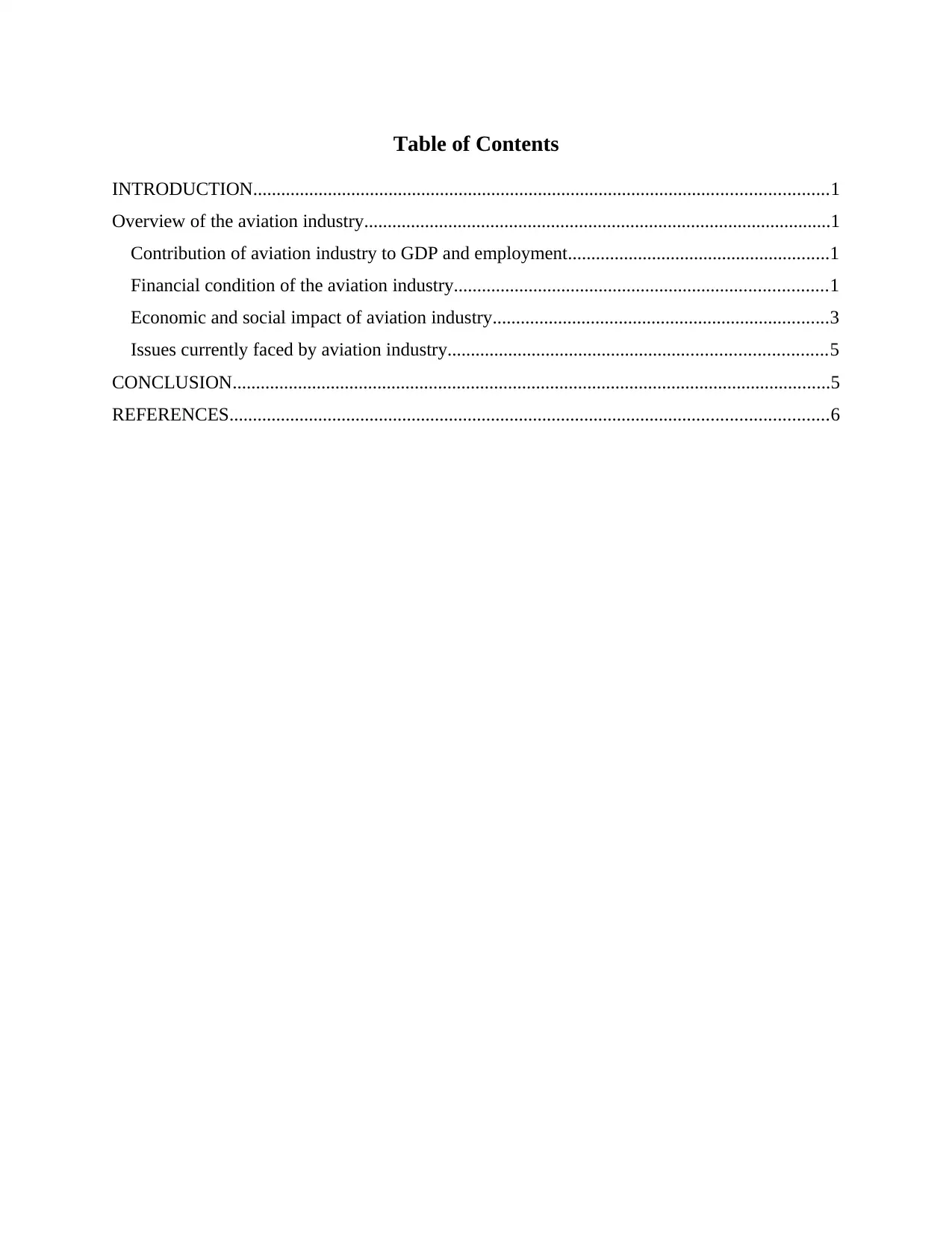
Table of Contents
INTRODUCTION...........................................................................................................................1
Overview of the aviation industry....................................................................................................1
Contribution of aviation industry to GDP and employment........................................................1
Financial condition of the aviation industry................................................................................1
Economic and social impact of aviation industry........................................................................3
Issues currently faced by aviation industry.................................................................................5
CONCLUSION................................................................................................................................5
REFERENCES................................................................................................................................6
INTRODUCTION...........................................................................................................................1
Overview of the aviation industry....................................................................................................1
Contribution of aviation industry to GDP and employment........................................................1
Financial condition of the aviation industry................................................................................1
Economic and social impact of aviation industry........................................................................3
Issues currently faced by aviation industry.................................................................................5
CONCLUSION................................................................................................................................5
REFERENCES................................................................................................................................6

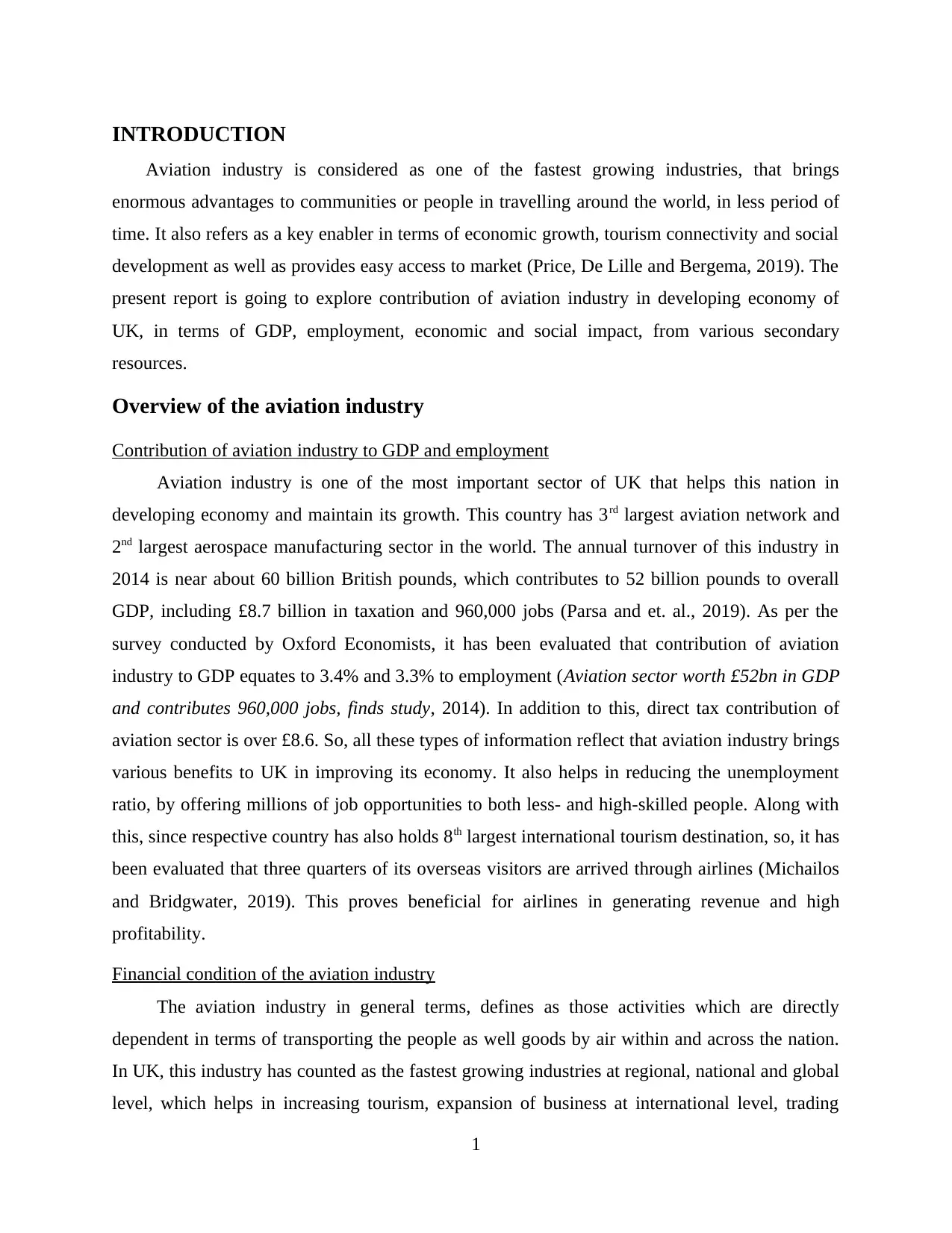
INTRODUCTION
Aviation industry is considered as one of the fastest growing industries, that brings
enormous advantages to communities or people in travelling around the world, in less period of
time. It also refers as a key enabler in terms of economic growth, tourism connectivity and social
development as well as provides easy access to market (Price, De Lille and Bergema, 2019). The
present report is going to explore contribution of aviation industry in developing economy of
UK, in terms of GDP, employment, economic and social impact, from various secondary
resources.
Overview of the aviation industry
Contribution of aviation industry to GDP and employment
Aviation industry is one of the most important sector of UK that helps this nation in
developing economy and maintain its growth. This country has 3rd largest aviation network and
2nd largest aerospace manufacturing sector in the world. The annual turnover of this industry in
2014 is near about 60 billion British pounds, which contributes to 52 billion pounds to overall
GDP, including £8.7 billion in taxation and 960,000 jobs (Parsa and et. al., 2019). As per the
survey conducted by Oxford Economists, it has been evaluated that contribution of aviation
industry to GDP equates to 3.4% and 3.3% to employment (Aviation sector worth £52bn in GDP
and contributes 960,000 jobs, finds study, 2014). In addition to this, direct tax contribution of
aviation sector is over £8.6. So, all these types of information reflect that aviation industry brings
various benefits to UK in improving its economy. It also helps in reducing the unemployment
ratio, by offering millions of job opportunities to both less- and high-skilled people. Along with
this, since respective country has also holds 8th largest international tourism destination, so, it has
been evaluated that three quarters of its overseas visitors are arrived through airlines (Michailos
and Bridgwater, 2019). This proves beneficial for airlines in generating revenue and high
profitability.
Financial condition of the aviation industry
The aviation industry in general terms, defines as those activities which are directly
dependent in terms of transporting the people as well goods by air within and across the nation.
In UK, this industry has counted as the fastest growing industries at regional, national and global
level, which helps in increasing tourism, expansion of business at international level, trading
1
Aviation industry is considered as one of the fastest growing industries, that brings
enormous advantages to communities or people in travelling around the world, in less period of
time. It also refers as a key enabler in terms of economic growth, tourism connectivity and social
development as well as provides easy access to market (Price, De Lille and Bergema, 2019). The
present report is going to explore contribution of aviation industry in developing economy of
UK, in terms of GDP, employment, economic and social impact, from various secondary
resources.
Overview of the aviation industry
Contribution of aviation industry to GDP and employment
Aviation industry is one of the most important sector of UK that helps this nation in
developing economy and maintain its growth. This country has 3rd largest aviation network and
2nd largest aerospace manufacturing sector in the world. The annual turnover of this industry in
2014 is near about 60 billion British pounds, which contributes to 52 billion pounds to overall
GDP, including £8.7 billion in taxation and 960,000 jobs (Parsa and et. al., 2019). As per the
survey conducted by Oxford Economists, it has been evaluated that contribution of aviation
industry to GDP equates to 3.4% and 3.3% to employment (Aviation sector worth £52bn in GDP
and contributes 960,000 jobs, finds study, 2014). In addition to this, direct tax contribution of
aviation sector is over £8.6. So, all these types of information reflect that aviation industry brings
various benefits to UK in improving its economy. It also helps in reducing the unemployment
ratio, by offering millions of job opportunities to both less- and high-skilled people. Along with
this, since respective country has also holds 8th largest international tourism destination, so, it has
been evaluated that three quarters of its overseas visitors are arrived through airlines (Michailos
and Bridgwater, 2019). This proves beneficial for airlines in generating revenue and high
profitability.
Financial condition of the aviation industry
The aviation industry in general terms, defines as those activities which are directly
dependent in terms of transporting the people as well goods by air within and across the nation.
In UK, this industry has counted as the fastest growing industries at regional, national and global
level, which helps in increasing tourism, expansion of business at international level, trading
1
Secure Best Marks with AI Grader
Need help grading? Try our AI Grader for instant feedback on your assignments.
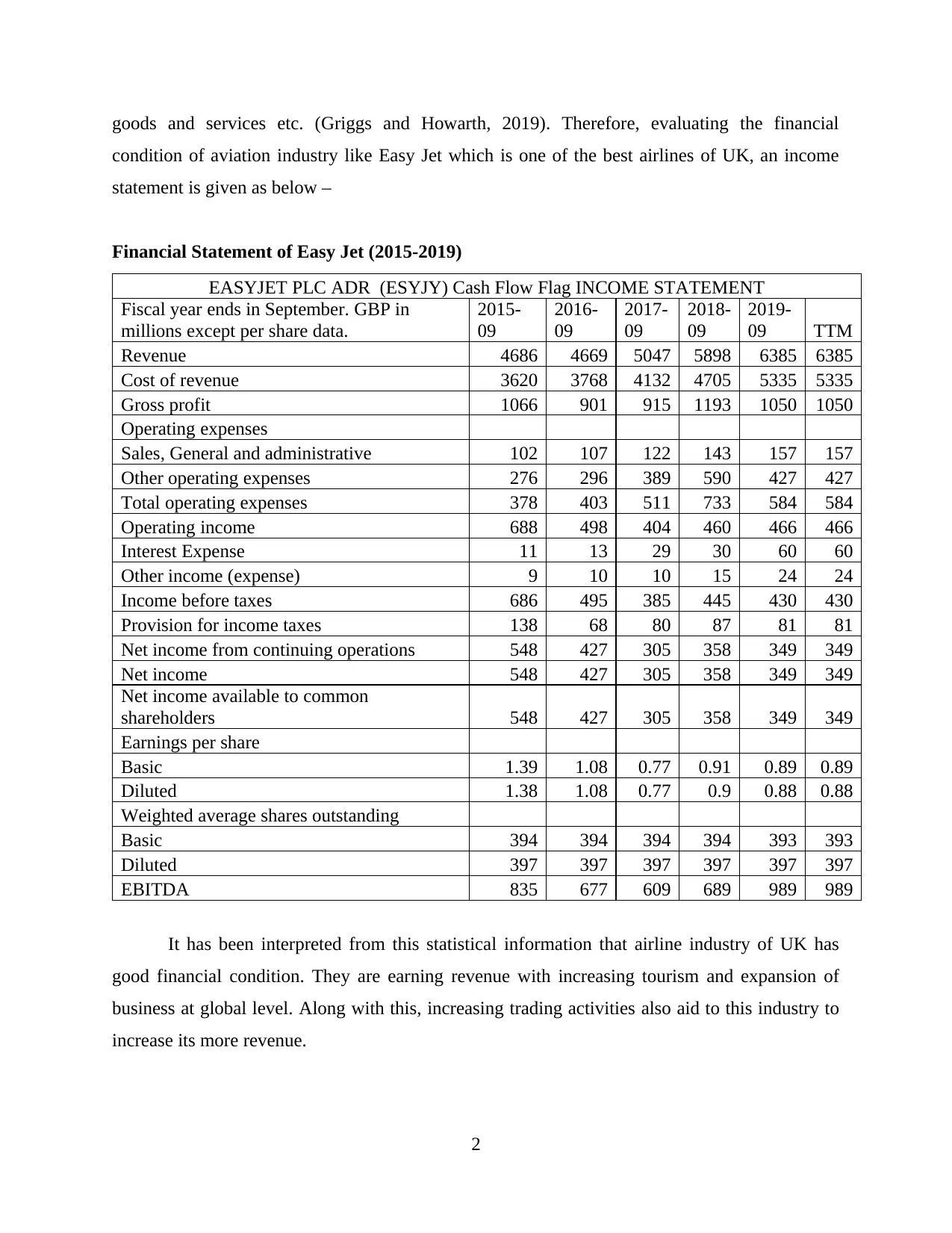
goods and services etc. (Griggs and Howarth, 2019). Therefore, evaluating the financial
condition of aviation industry like Easy Jet which is one of the best airlines of UK, an income
statement is given as below –
Financial Statement of Easy Jet (2015-2019)
EASYJET PLC ADR (ESYJY) Cash Flow Flag INCOME STATEMENT
Fiscal year ends in September. GBP in
millions except per share data.
2015-
09
2016-
09
2017-
09
2018-
09
2019-
09 TTM
Revenue 4686 4669 5047 5898 6385 6385
Cost of revenue 3620 3768 4132 4705 5335 5335
Gross profit 1066 901 915 1193 1050 1050
Operating expenses
Sales, General and administrative 102 107 122 143 157 157
Other operating expenses 276 296 389 590 427 427
Total operating expenses 378 403 511 733 584 584
Operating income 688 498 404 460 466 466
Interest Expense 11 13 29 30 60 60
Other income (expense) 9 10 10 15 24 24
Income before taxes 686 495 385 445 430 430
Provision for income taxes 138 68 80 87 81 81
Net income from continuing operations 548 427 305 358 349 349
Net income 548 427 305 358 349 349
Net income available to common
shareholders 548 427 305 358 349 349
Earnings per share
Basic 1.39 1.08 0.77 0.91 0.89 0.89
Diluted 1.38 1.08 0.77 0.9 0.88 0.88
Weighted average shares outstanding
Basic 394 394 394 394 393 393
Diluted 397 397 397 397 397 397
EBITDA 835 677 609 689 989 989
It has been interpreted from this statistical information that airline industry of UK has
good financial condition. They are earning revenue with increasing tourism and expansion of
business at global level. Along with this, increasing trading activities also aid to this industry to
increase its more revenue.
2
condition of aviation industry like Easy Jet which is one of the best airlines of UK, an income
statement is given as below –
Financial Statement of Easy Jet (2015-2019)
EASYJET PLC ADR (ESYJY) Cash Flow Flag INCOME STATEMENT
Fiscal year ends in September. GBP in
millions except per share data.
2015-
09
2016-
09
2017-
09
2018-
09
2019-
09 TTM
Revenue 4686 4669 5047 5898 6385 6385
Cost of revenue 3620 3768 4132 4705 5335 5335
Gross profit 1066 901 915 1193 1050 1050
Operating expenses
Sales, General and administrative 102 107 122 143 157 157
Other operating expenses 276 296 389 590 427 427
Total operating expenses 378 403 511 733 584 584
Operating income 688 498 404 460 466 466
Interest Expense 11 13 29 30 60 60
Other income (expense) 9 10 10 15 24 24
Income before taxes 686 495 385 445 430 430
Provision for income taxes 138 68 80 87 81 81
Net income from continuing operations 548 427 305 358 349 349
Net income 548 427 305 358 349 349
Net income available to common
shareholders 548 427 305 358 349 349
Earnings per share
Basic 1.39 1.08 0.77 0.91 0.89 0.89
Diluted 1.38 1.08 0.77 0.9 0.88 0.88
Weighted average shares outstanding
Basic 394 394 394 394 393 393
Diluted 397 397 397 397 397 397
EBITDA 835 677 609 689 989 989
It has been interpreted from this statistical information that airline industry of UK has
good financial condition. They are earning revenue with increasing tourism and expansion of
business at global level. Along with this, increasing trading activities also aid to this industry to
increase its more revenue.
2
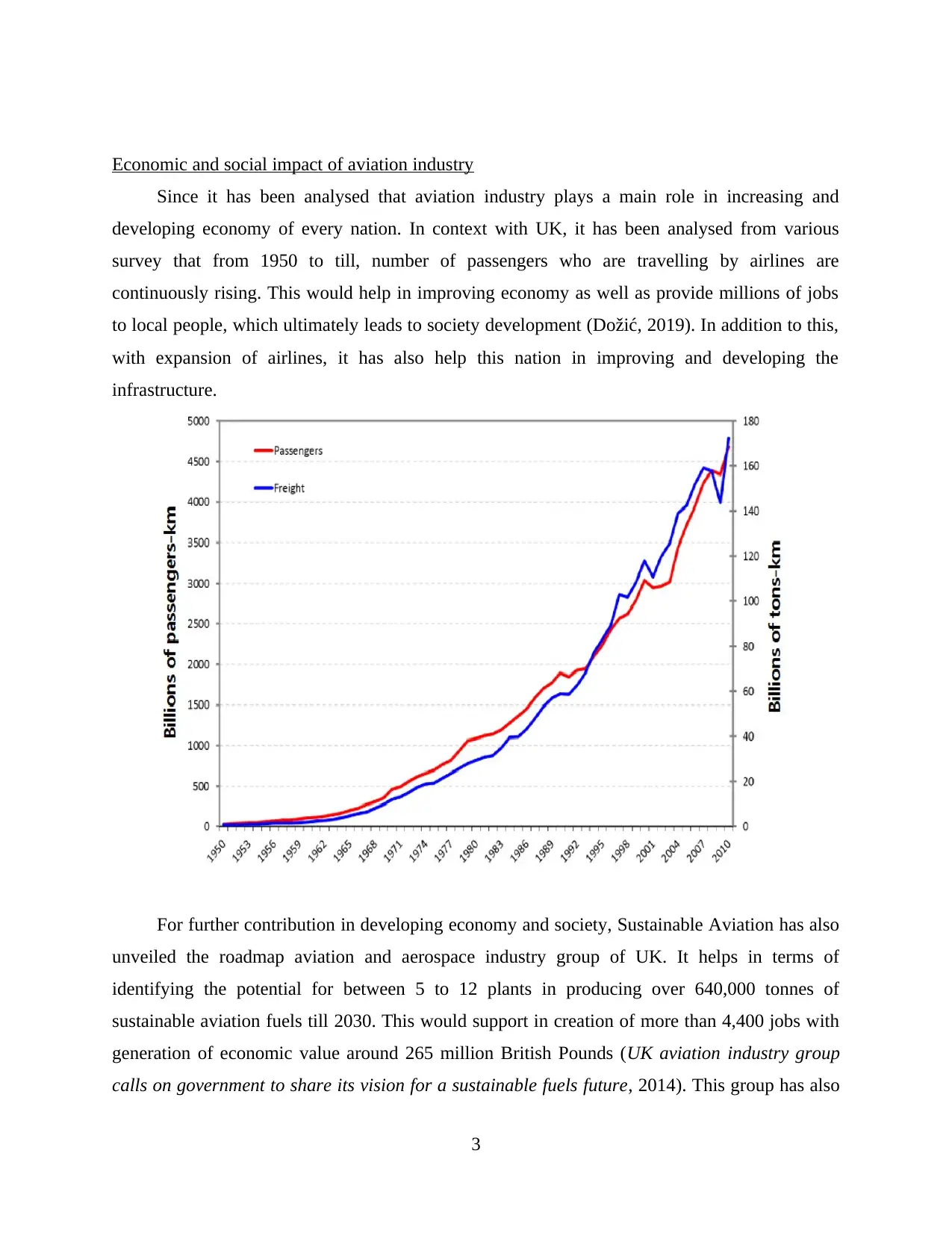
Economic and social impact of aviation industry
Since it has been analysed that aviation industry plays a main role in increasing and
developing economy of every nation. In context with UK, it has been analysed from various
survey that from 1950 to till, number of passengers who are travelling by airlines are
continuously rising. This would help in improving economy as well as provide millions of jobs
to local people, which ultimately leads to society development (Dožić, 2019). In addition to this,
with expansion of airlines, it has also help this nation in improving and developing the
infrastructure.
For further contribution in developing economy and society, Sustainable Aviation has also
unveiled the roadmap aviation and aerospace industry group of UK. It helps in terms of
identifying the potential for between 5 to 12 plants in producing over 640,000 tonnes of
sustainable aviation fuels till 2030. This would support in creation of more than 4,400 jobs with
generation of economic value around 265 million British Pounds (UK aviation industry group
calls on government to share its vision for a sustainable fuels future, 2014). This group has also
3
Since it has been analysed that aviation industry plays a main role in increasing and
developing economy of every nation. In context with UK, it has been analysed from various
survey that from 1950 to till, number of passengers who are travelling by airlines are
continuously rising. This would help in improving economy as well as provide millions of jobs
to local people, which ultimately leads to society development (Dožić, 2019). In addition to this,
with expansion of airlines, it has also help this nation in improving and developing the
infrastructure.
For further contribution in developing economy and society, Sustainable Aviation has also
unveiled the roadmap aviation and aerospace industry group of UK. It helps in terms of
identifying the potential for between 5 to 12 plants in producing over 640,000 tonnes of
sustainable aviation fuels till 2030. This would support in creation of more than 4,400 jobs with
generation of economic value around 265 million British Pounds (UK aviation industry group
calls on government to share its vision for a sustainable fuels future, 2014). This group has also
3
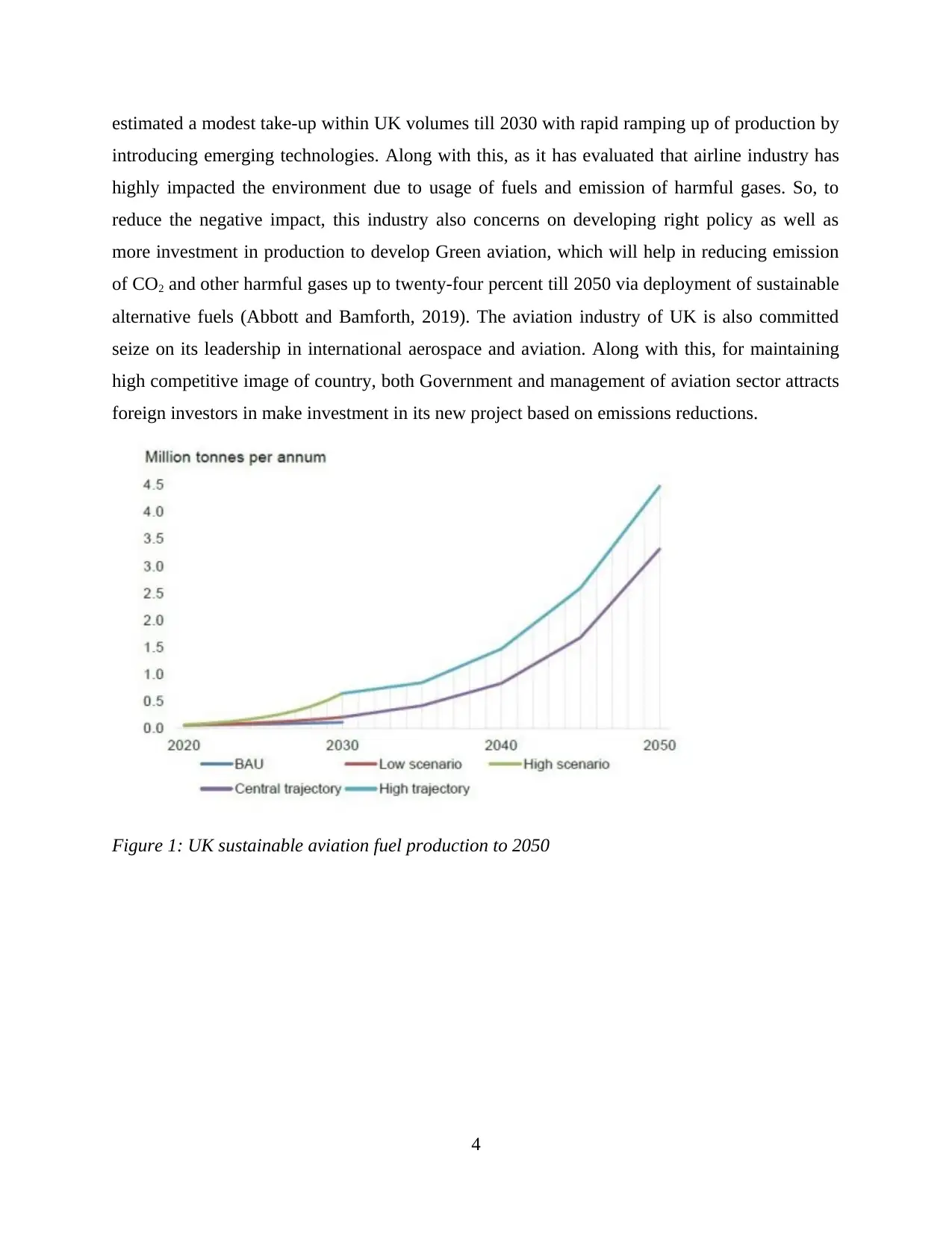
estimated a modest take-up within UK volumes till 2030 with rapid ramping up of production by
introducing emerging technologies. Along with this, as it has evaluated that airline industry has
highly impacted the environment due to usage of fuels and emission of harmful gases. So, to
reduce the negative impact, this industry also concerns on developing right policy as well as
more investment in production to develop Green aviation, which will help in reducing emission
of CO2 and other harmful gases up to twenty-four percent till 2050 via deployment of sustainable
alternative fuels (Abbott and Bamforth, 2019). The aviation industry of UK is also committed
seize on its leadership in international aerospace and aviation. Along with this, for maintaining
high competitive image of country, both Government and management of aviation sector attracts
foreign investors in make investment in its new project based on emissions reductions.
Figure 1: UK sustainable aviation fuel production to 2050
4
introducing emerging technologies. Along with this, as it has evaluated that airline industry has
highly impacted the environment due to usage of fuels and emission of harmful gases. So, to
reduce the negative impact, this industry also concerns on developing right policy as well as
more investment in production to develop Green aviation, which will help in reducing emission
of CO2 and other harmful gases up to twenty-four percent till 2050 via deployment of sustainable
alternative fuels (Abbott and Bamforth, 2019). The aviation industry of UK is also committed
seize on its leadership in international aerospace and aviation. Along with this, for maintaining
high competitive image of country, both Government and management of aviation sector attracts
foreign investors in make investment in its new project based on emissions reductions.
Figure 1: UK sustainable aviation fuel production to 2050
4
Paraphrase This Document
Need a fresh take? Get an instant paraphrase of this document with our AI Paraphraser
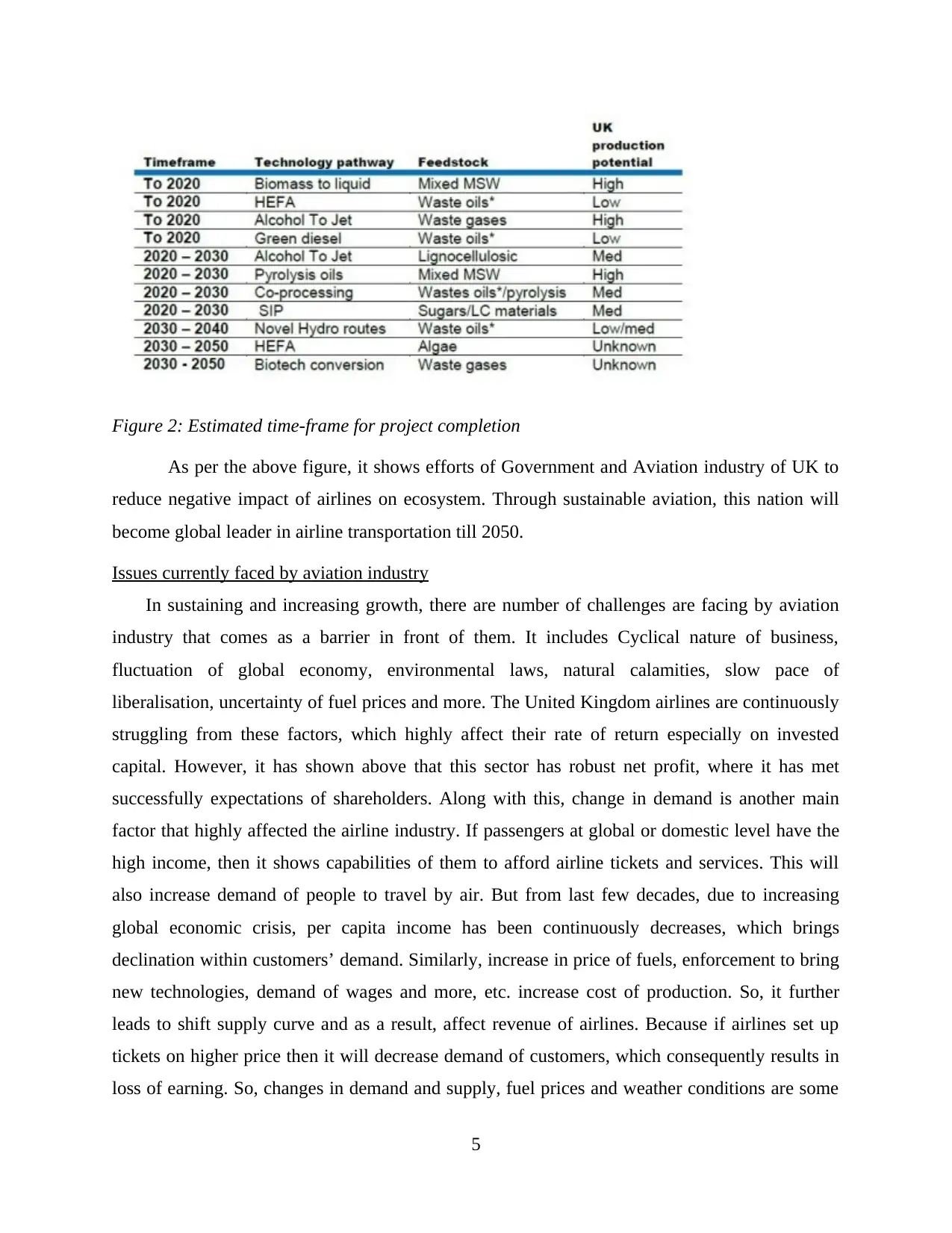
Figure 2: Estimated time-frame for project completion
As per the above figure, it shows efforts of Government and Aviation industry of UK to
reduce negative impact of airlines on ecosystem. Through sustainable aviation, this nation will
become global leader in airline transportation till 2050.
Issues currently faced by aviation industry
In sustaining and increasing growth, there are number of challenges are facing by aviation
industry that comes as a barrier in front of them. It includes Cyclical nature of business,
fluctuation of global economy, environmental laws, natural calamities, slow pace of
liberalisation, uncertainty of fuel prices and more. The United Kingdom airlines are continuously
struggling from these factors, which highly affect their rate of return especially on invested
capital. However, it has shown above that this sector has robust net profit, where it has met
successfully expectations of shareholders. Along with this, change in demand is another main
factor that highly affected the airline industry. If passengers at global or domestic level have the
high income, then it shows capabilities of them to afford airline tickets and services. This will
also increase demand of people to travel by air. But from last few decades, due to increasing
global economic crisis, per capita income has been continuously decreases, which brings
declination within customers’ demand. Similarly, increase in price of fuels, enforcement to bring
new technologies, demand of wages and more, etc. increase cost of production. So, it further
leads to shift supply curve and as a result, affect revenue of airlines. Because if airlines set up
tickets on higher price then it will decrease demand of customers, which consequently results in
loss of earning. So, changes in demand and supply, fuel prices and weather conditions are some
5
As per the above figure, it shows efforts of Government and Aviation industry of UK to
reduce negative impact of airlines on ecosystem. Through sustainable aviation, this nation will
become global leader in airline transportation till 2050.
Issues currently faced by aviation industry
In sustaining and increasing growth, there are number of challenges are facing by aviation
industry that comes as a barrier in front of them. It includes Cyclical nature of business,
fluctuation of global economy, environmental laws, natural calamities, slow pace of
liberalisation, uncertainty of fuel prices and more. The United Kingdom airlines are continuously
struggling from these factors, which highly affect their rate of return especially on invested
capital. However, it has shown above that this sector has robust net profit, where it has met
successfully expectations of shareholders. Along with this, change in demand is another main
factor that highly affected the airline industry. If passengers at global or domestic level have the
high income, then it shows capabilities of them to afford airline tickets and services. This will
also increase demand of people to travel by air. But from last few decades, due to increasing
global economic crisis, per capita income has been continuously decreases, which brings
declination within customers’ demand. Similarly, increase in price of fuels, enforcement to bring
new technologies, demand of wages and more, etc. increase cost of production. So, it further
leads to shift supply curve and as a result, affect revenue of airlines. Because if airlines set up
tickets on higher price then it will decrease demand of customers, which consequently results in
loss of earning. So, changes in demand and supply, fuel prices and weather conditions are some
5
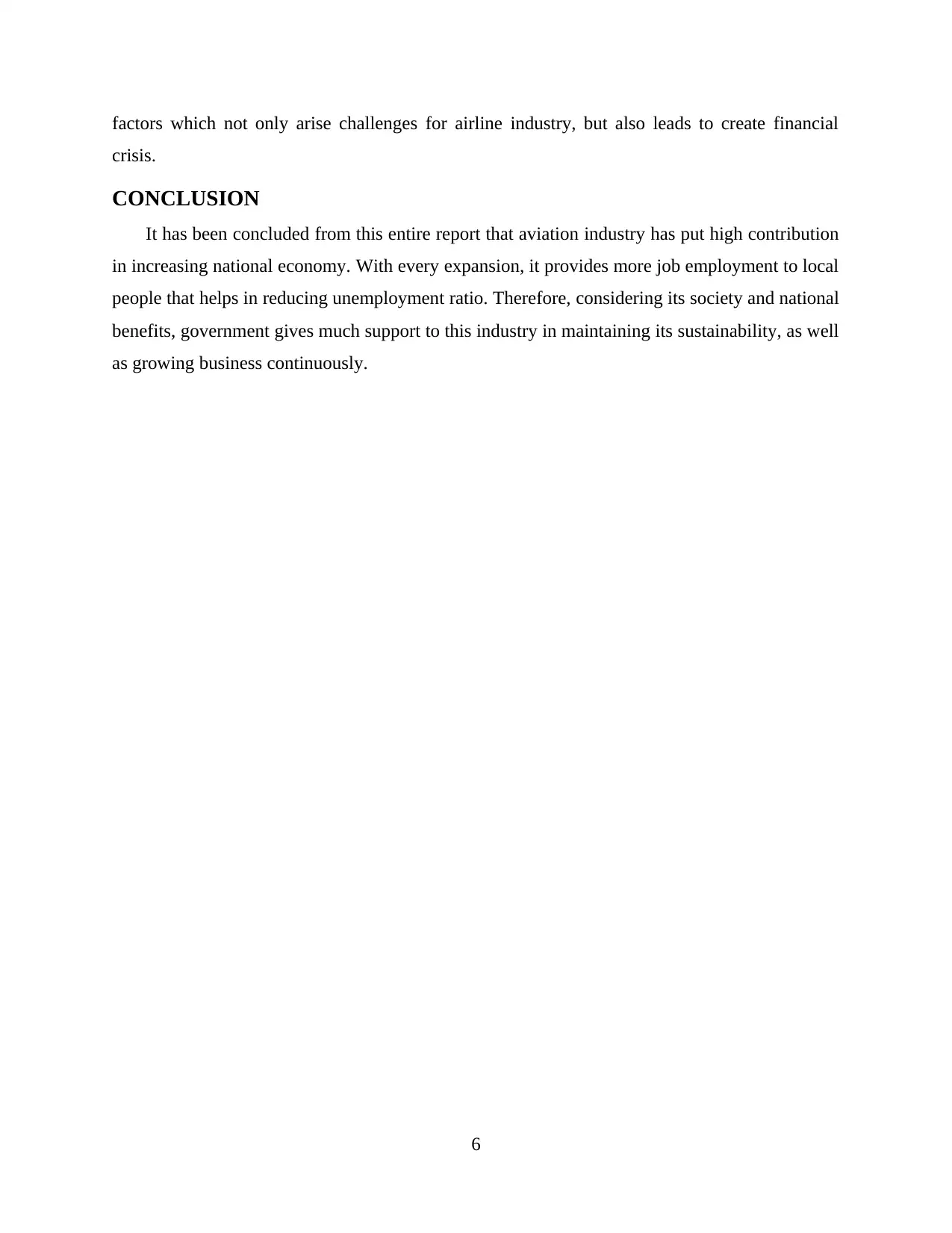
factors which not only arise challenges for airline industry, but also leads to create financial
crisis.
CONCLUSION
It has been concluded from this entire report that aviation industry has put high contribution
in increasing national economy. With every expansion, it provides more job employment to local
people that helps in reducing unemployment ratio. Therefore, considering its society and national
benefits, government gives much support to this industry in maintaining its sustainability, as well
as growing business continuously.
6
crisis.
CONCLUSION
It has been concluded from this entire report that aviation industry has put high contribution
in increasing national economy. With every expansion, it provides more job employment to local
people that helps in reducing unemployment ratio. Therefore, considering its society and national
benefits, government gives much support to this industry in maintaining its sustainability, as well
as growing business continuously.
6
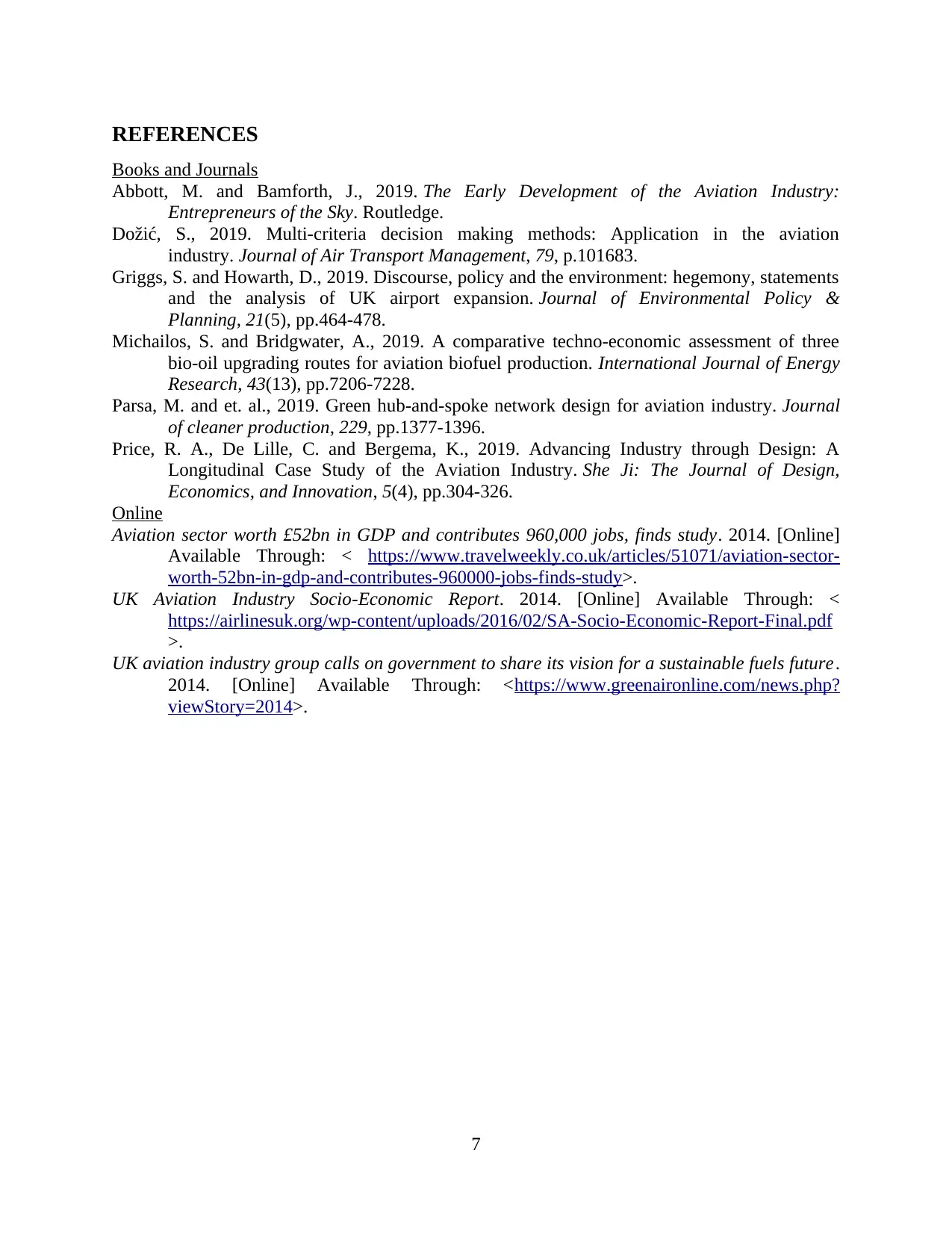
REFERENCES
Books and Journals
Abbott, M. and Bamforth, J., 2019. The Early Development of the Aviation Industry:
Entrepreneurs of the Sky. Routledge.
Dožić, S., 2019. Multi-criteria decision making methods: Application in the aviation
industry. Journal of Air Transport Management, 79, p.101683.
Griggs, S. and Howarth, D., 2019. Discourse, policy and the environment: hegemony, statements
and the analysis of UK airport expansion. Journal of Environmental Policy &
Planning, 21(5), pp.464-478.
Michailos, S. and Bridgwater, A., 2019. A comparative techno‐economic assessment of three
bio‐oil upgrading routes for aviation biofuel production. International Journal of Energy
Research, 43(13), pp.7206-7228.
Parsa, M. and et. al., 2019. Green hub-and-spoke network design for aviation industry. Journal
of cleaner production, 229, pp.1377-1396.
Price, R. A., De Lille, C. and Bergema, K., 2019. Advancing Industry through Design: A
Longitudinal Case Study of the Aviation Industry. She Ji: The Journal of Design,
Economics, and Innovation, 5(4), pp.304-326.
Online
Aviation sector worth £52bn in GDP and contributes 960,000 jobs, finds study. 2014. [Online]
Available Through: < https://www.travelweekly.co.uk/articles/51071/aviation-sector-
worth-52bn-in-gdp-and-contributes-960000-jobs-finds-study>.
UK Aviation Industry Socio-Economic Report. 2014. [Online] Available Through: <
https://airlinesuk.org/wp-content/uploads/2016/02/SA-Socio-Economic-Report-Final.pdf
>.
UK aviation industry group calls on government to share its vision for a sustainable fuels future.
2014. [Online] Available Through: <https://www.greenaironline.com/news.php?
viewStory=2014>.
7
Books and Journals
Abbott, M. and Bamforth, J., 2019. The Early Development of the Aviation Industry:
Entrepreneurs of the Sky. Routledge.
Dožić, S., 2019. Multi-criteria decision making methods: Application in the aviation
industry. Journal of Air Transport Management, 79, p.101683.
Griggs, S. and Howarth, D., 2019. Discourse, policy and the environment: hegemony, statements
and the analysis of UK airport expansion. Journal of Environmental Policy &
Planning, 21(5), pp.464-478.
Michailos, S. and Bridgwater, A., 2019. A comparative techno‐economic assessment of three
bio‐oil upgrading routes for aviation biofuel production. International Journal of Energy
Research, 43(13), pp.7206-7228.
Parsa, M. and et. al., 2019. Green hub-and-spoke network design for aviation industry. Journal
of cleaner production, 229, pp.1377-1396.
Price, R. A., De Lille, C. and Bergema, K., 2019. Advancing Industry through Design: A
Longitudinal Case Study of the Aviation Industry. She Ji: The Journal of Design,
Economics, and Innovation, 5(4), pp.304-326.
Online
Aviation sector worth £52bn in GDP and contributes 960,000 jobs, finds study. 2014. [Online]
Available Through: < https://www.travelweekly.co.uk/articles/51071/aviation-sector-
worth-52bn-in-gdp-and-contributes-960000-jobs-finds-study>.
UK Aviation Industry Socio-Economic Report. 2014. [Online] Available Through: <
https://airlinesuk.org/wp-content/uploads/2016/02/SA-Socio-Economic-Report-Final.pdf
>.
UK aviation industry group calls on government to share its vision for a sustainable fuels future.
2014. [Online] Available Through: <https://www.greenaironline.com/news.php?
viewStory=2014>.
7
1 out of 10
Related Documents
Your All-in-One AI-Powered Toolkit for Academic Success.
+13062052269
info@desklib.com
Available 24*7 on WhatsApp / Email
![[object Object]](/_next/static/media/star-bottom.7253800d.svg)
Unlock your academic potential
© 2024 | Zucol Services PVT LTD | All rights reserved.





